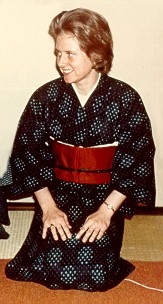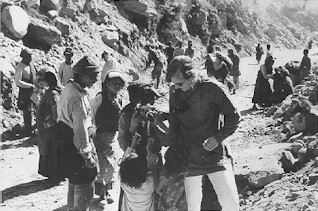Like many growing up in the West, eating seemed
more like an aesthetic event than a medical necessity. On
some vague level, I understood that food promotes growth, but I
suspect I thought of this more in terms of quantity than quality;
and I really had very little grasp of the pharmacological nuances
of food beyond the notion that sweets are probably fattening. After
studying Ayurveda, I realized that sweets are actually a sedative,
and I came to believe that my mother intuitively understood this
when she used ice cream to subdue me when my fires were out of
control as a child.
 I
majored in Asian Studies at the East-West Center of the University
of Hawaii (B.A. 1962.) As an undergraduate, I had preferred
philosophy and anthropology to disciplines that might lead to
a real career. Upon graduation, I went to Japan as an exchange
student. There, I continued to study Japanese language and
Buddhism, but on a particularly calm and quiet Sunday in Karuizawa,
I read a report in the Japan Times about a tribe in Africa in
which the entire adult population was blind, and children were
used as seeing eyes. I flew into a rage. I realized
that sanitation and health care would only shift the problem
for these unfortunate people a little. However, if they
were educated, they stood a better chance of fending for
themselves in a risky world. I decided that economic development
would generate the opportunities for a higher standard of education
as well as health care. I therefore applied to Yale and
was told that my application was peculiarly irresistible.
I
majored in Asian Studies at the East-West Center of the University
of Hawaii (B.A. 1962.) As an undergraduate, I had preferred
philosophy and anthropology to disciplines that might lead to
a real career. Upon graduation, I went to Japan as an exchange
student. There, I continued to study Japanese language and
Buddhism, but on a particularly calm and quiet Sunday in Karuizawa,
I read a report in the Japan Times about a tribe in Africa in
which the entire adult population was blind, and children were
used as seeing eyes. I flew into a rage. I realized
that sanitation and health care would only shift the problem
for these unfortunate people a little. However, if they
were educated, they stood a better chance of fending for
themselves in a risky world. I decided that economic development
would generate the opportunities for a higher standard of education
as well as health care. I therefore applied to Yale and
was told that my application was peculiarly irresistible.
I received an M.A. in Development Economics at
Yale University in 1964. From there, I joined the work
force, first as a research analyst for the United States Trust
Company and later as an economist for the Department of State in
Vietnam and India. As a consequence of the experiences I gathered
during these, my only "formal" jobs, I learned some startling
and life transforming facts.

First, as the only woman in the bank's research
department at a time when companies were not yet obliged to have
their "token" women employees, I was initially put in
charge of the food and beverage industry. There, I learned
unsettling specifics that everyone needs to know in order to survive.
My first summer on Wall Street cost me my innocence.
The chemical and drug analyst was on vacation when the Vatican
was to reach a decision on birth control. I spent my evenings
reading files on pharmaceutical companies and realized that I would
never again take so much as an aspirin unless it had been on the
market for at least twenty-five years, preferably fifty. Pressure
by management on research to develop products ahead of the competition
had resulted in what seemed a pattern of falsification of data. In
those days, the era of the thalidomide scandal, companies were
failing to report dead monkeys and hyping new wonder drugs that,
according to the legal papers I was studying, were rife with side
effects and probably not capable of delivering the results promised.

After Wall Street, I went to Vietnam (1966-68)
where I discovered more political ineptitude and more hazards associated
with medicine. I had been inoculated for everything under
the sun and was beginning to show classic signs of iatrogenic pathologies. My
fevers only got worse in India. I decided to forge entries
on my yellow card to avoid more injections of morbid matter, and,
in a quest for an entirely different approach to health, I discovered
Ayurveda!
In India, the pieces started to fit together. I
was surrounded by ancient wisdom, piety, and more importantly a
system of medicine that was essentially philosophical rather than
scientific. I devoured everything I could on Tibetan and Ayurvedic
medicine and came eventually to realize that the taste of food
is a clue not only to its aesthetics but to its pharmacology. This
system is totally different from the food groups we are taught
in grade school; it is also different from the categorization of
food as carbohydrates, fats, and protein, the foundations of Western
nutrition. Ayurveda is not concerned with calories so much
as the digestibility of food. It does not teach a pat formula
for eating such as we continue to uphold in the West by referencing
minimum daily requirements for various vitamins and nutrients.
Constitutional Type
Ayurveda teaches that each person is unique. Each
person is born with a body that has characteristics and idiosyncrasies
unique to himself or herself. Every constitution is different;
and what works for one person is therefore different than what
works for another. Then, from the day we are born, we begin
modifying our bodies in accordance with what we eat, the seasons,
where we live, and various other factors such as environmental
hazards, stress due to personal circumstances and relationships,
and Cosmic factors such as the cycles of astronomical forces.
By 1980, I had interfaced the basics of Ayurvedic
pharmacology with spiritual psychology and astrology, and in 1986,
I began working on the foundations of what I dubbed Kitchen
Doctor, culinary approaches to health management that
involve extensive use of herbs and spices. Little by little,
as the dots connected, my lectures on constitutional
type and temperament were welcomed by individuals with health
issues, including many mothers concerned for their children.
I always wanted to publish my work as a two-volume
opus, but the requisite funds were never available and one manuscript
was stolen from me. Now, with the advent of the Internet
and the tremendous resource it provides for people with independent
minds and spirits to investigate their healing options, I decided
to start a web site in which I can gradually add pages as my time
permits. I am doing this largely as a public service and therefore
welcome your questions and
will try to post as much material as visitor interest warrants. Please,
therefore, feel free to write. In the meantime, enjoy your
visit.
Blessings,
Ingrid
KitchenDoctor.com was registered in February 2001 so this message was written in 2001.


![]() Contact Us || Sacred Medicine Sanctuary & FAQ || Subscription Management
Contact Us || Sacred Medicine Sanctuary & FAQ || Subscription Management 




